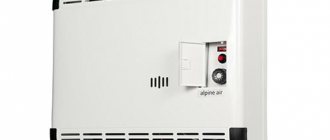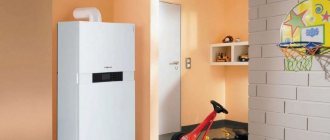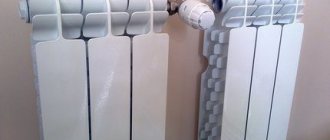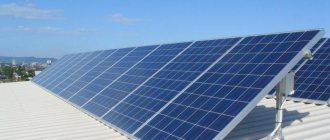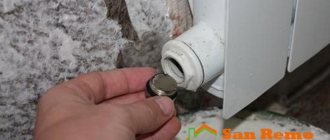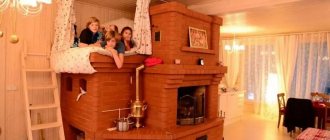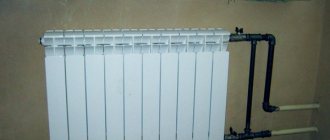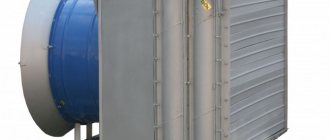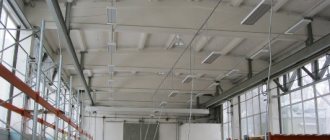Electric heater installation EKU.
| An electric heating unit (ECU) is designed for heating industrial and agricultural premises; it is also used in construction for drying plaster, building materials, paint and creating comfortable conditions when performing work. During operation, the installation creates a difference in the temperature of incoming and outgoing air from +35 to +65ºС, which allows it to be used for supply ventilation and heating in recirculation mode. If necessary, in warm weather the installation can be used as a high-performance fan by turning off the electric heater; reduce the temperature difference between incoming and outgoing air by turning off ECU sections. The installation is used in enclosed spaces at an ambient temperature of -20 to +40ºС, free of flammable substances and dust. Can be installed on a platform or suspended from brackets. The electric heater installation consists of: an electric heater, an axial fan VO-06-300. |
TECHNICAL CHARACTERISTICS OF HEATING UNITS EKU12, EKU21, EKU42, EKU64, EKU90:
| EKU-12 | EKU-21 | EKU-42 | EKU-64 | EKU-90 | |
| Analogs | |||||
| EK-12 | EK-21 | EK-42 | EK-60 | KEV-90T | |
| KEV-12 | KEV-21 | KEV-42 | KEV-60 | SFO-99 | |
| KEV-18T | KEV-24T | KEV-60T | SFOA-90 | ||
| power, kWt | 12 | 21 | 42 | 64 | 90 |
| Air capacity, m³/h. | 1000 | 1000 | 3000 | 50003000 | 11000 |
| Temperature difference between incoming and outgoing air, ºС, no more | 35 | 45 | 55 | 3565 | 2535 |
| Number of sections | 2 | 3 | 2 | 3 | 3 |
| Degree of protection | 1Р30 | ||||
| Fan | VO-06-300-3.15 | VO-06-300-4.0 | VO-06-300-6.3 | ||
| Power/number of revolutions, kW/min-1 | 0,18/1000 | 0,25/1500 | 0,25/1500 | 0,75/30000,25/1500 | 1,1/1500 |
| Voltage type, V/Hz | 380/50 | ||||
| Overall dimensions: length×width×height, mm | 735×632×510 | 735×632×570 | 755×755×625 | 780×755×625 | 900×970×855 |
| Weight, kg | 40 | 45 | 55 | 6762 | 105 |
Air heating units AO-2 and STD-3000 with axial fans
Home / Heating / Heating units
Filter
| In regions with temperate and cold climates, enterprises use air-heating units (AHE) to use production and industrial premises during the cold season. Air-heat units are designed for air heating of production premises and industrial buildings using hot water or superheated water/steam as a coolant. Such equipment can be used not only for the needs of industry or production - its use is justified wherever there is a need for high-quality heating of large areas. Heating units of the AO 2 series are used for heating premises for various purposes: industrial, agricultural or production; the equipment uses hot or superheated water as a coolant. High efficiency of use of heating units AO 2 is achieved thanks to the thoughtful design of equipment in this series. |
| Parameter | AO2-3 | AO2-4 | AO2-6.3 | AO2-10 | AO2-20 | AO2-25 | AO2-50 |
| Air capacity, m3/hour | 2600 | 4000 | 6300 | 10000 | 20000 | 25000 | 60000 |
| Heat output, kW | 24 | 46 | 73 | 116 | 220 | 306 | 900 |
| Selling price of the unit, rub. | 21430 | 22323 | 24129 | 37023 | 51282 | 65215 | 132279 |
| Supply/return coolant temperature, °C | 150/70 | ||||||
| Axial fan type VO-14-320 (VO-06-300), standard size (No.) | 4 | 5 | 6,3 | 8 | 12,5 | ||
| Installed power, kW | 0,25 | 0,37 | 0,55 | 0,75 | 3,0 | 7,5 | |
| Rotation speed, rpm | 1500 | 1500 | 1500 | 1000 | 1500 | 1000 | |
| Section for coolant passage, m² | 0,00079 | 0,00102 | 0,00113 | 0,00147 | 0,00203 | 0,00249 | |
| Pipe cross-section, m² | 0,00101 | 0,00221 | |||||
| Pipe diameter DN, mm | 32 | 50 | |||||
| Number of moves | 4 | ||||||
| Number of rows | 3 | 4 | |||||
| Water consumption, m3/hour, at water speed in pipes w=0.7-1.0 m/s | 1,9-2,7 | 2,4-3,45 | 2,4-3,45 | 3,5-5,0 | 4,9-6,9 | 5,3-7,5 | |
| Acoustic characteristics (“sound power”), dB | 80 | 88 | 99 | 100 | 110 | 110 | 120 |
| Weight, kg | 70 | 95 | 120 | 160 | 255 | 280 | 820 |
| Selling price of heater for the unit, per 1 piece, rub. | 9’920 | 9’980 | 13’200 | 19’400 | 25’410 | 33’650 | 38’980 |
The AO 2 unit is manufactured in two versions: right and left.
- The right-hand version assumes that the heater pipe is located on the right side of the device, when viewed from the side of the axial fan.
- Left version The nozzles are located on the left of the device when looking at it from the side of the axial fan.
- Name
- Name
- Price
- Price
- Rating
- Rating
- Reset
Sort by:
Air heating units of the AO-2 series operate with supply air or indoor air, the dust concentration in which should not exceed 0.5 mg/m3. AO2 units are used in areas with temperate and cold climates and are placed in rooms with an air environment containing dust and other solid impurities of no more than 0.5 mg/m3, and also free of sticky substances and fibrous materials. The presence of fibers or sticky substances in the working environment is not permitted. Other requirements for air are according to State Standards. Standard 12.1.005-88.
The air heating unit is a simple design consisting of a single block. The unit includes:
The main elements of the device are a water or steam heater (AO2 and AO2-P, respectively) and an axial fan VO 06-300. The heater is presented in the form of a multi-row coil made of steel pipes with aluminum fins, which increases the intensity of heat exchange between the heating part and the incoming air flow. On the front side of the heater there is a grille with movable blinds that regulate the direction of air flow. That is, to simplify the heating unit AO 2, water or steam, it is a heater with a fan for air heating of industrial and agricultural premises In other words, from a design point of view, air heating units are powerful, efficient fans that supply heated air to rooms so that it is evenly distributed throughout them. Air heating units (AHUs), depending on the modification, can have different power and, accordingly, different performance. The use of air heating units (AHE) allows you to warm up rooms quickly enough, as well as accurately maintain the set temperature for a long time. |
The supporting part is a welded frame. Installation of the unit can be carried out in two ways: using anchor fastening to the floor foundation or using special eyes on suspensions. On the side of the heater there are inlet and outlet pipes, through which the heater is connected to the steam or hot water supply system. When using a water heater in units, additional protection is required to prevent the coolant from freezing. Steam models do not require such protection.
The unit is installed or suspended on brackets. During operation of the unit, the air supplied by the fan is heated, passing through the heater and supplied to the room. Air heating units have high thermal performance and efficiency, which are ensured by the optimal distance between the fan and the heater, which eliminates stagnant zones when air moves in the unit, as well as the use of high-quality heaters and axial fans.
The AO unit is an air-heating equipment designed for heating, air heating of industrial, civil and agricultural premises and acting as an element of ventilation and air heating systems for various large premises; they are widely used in workshops, hangars, garages, warehouse areas, farms , industrial, warehouse, retail and other premises of categories D and D, the technological process in which is not accompanied by the release of dust and explosive gases, etc. The AO2 unit can work both to heat the air in the room (the main purpose) and simply as an air curtain . In the cold season, this unit can work to heat the supply air, and in the summer it is used as a regular fan. The heating unit AO2 is designed for air heating of production premises and industrial buildings. These devices can also be used for non-evaporative cooling of liquids in technological chains as air cooling devices (dry coolers) with low water consumption.
In general, heating units are a proven and reliable tool for heating large areas, which have been actively used all over the world for many years. They are needed where it is difficult to use heat guns or convectors and at the same time there is accessible network hot water. Such heating of a room using hot water is much more economical than heating with electricity due to its high cost.
Air heating units AO 2 comply with all norms and standards of reliability and quality accepted in Russia for equipment of this category. Currently, AO 2 air heating units are produced in several modifications, differing from each other in technical and operational characteristics, including power and performance. This allows you to select equipment for heating production and industrial premises in strict accordance with all the requirements of future operation so that its use is as efficient as possible in each specific case.
Air-heat units (AHT) are quite reliable and durable equipment that can fully function for many years. When using them, the rooms are heated quickly enough, and the set temperature level is maintained with high accuracy. Thanks to many years of production experience and simplicity of design, heating units are reliable and durable in operation. Installation and operation of air heating units (AHUs) are not particularly difficult; such equipment is undemanding in maintenance and almost never needs repairs. You can use them for many years without major repairs. Operation of the AO 2 series devices is quite simple and convenient, and is absolutely safe
You can buy heating units, a water-based air heating unit with a water heat exchanger, a KSK water heater for a heating unit, fans for heating units, electric motors for a heating unit, heating equipment
through the catalog in the online store format, go to the product page by clicking on it and using the standard forms on the product page
| |
and
| |
| To receive a completed commercial proposal in the form for organizations or to issue an invoice for a legal entity | |
Preparation of accounting documents according to the Tax Code of the Russian Federation with VAT Consignment note in the form TORG-12 | |
Contact us
Do you have a question, haven’t found the equipment you need, or something else?
| use special forms or or by email |
If equipment selection is required, indicate the maximum possible amount of available data, preferences, restrictions, or vice versa possible changes
and/or fill out the questionnaire
Types of water convector radiators
A convector heating radiator can be floor-mounted, wall-mounted, in-floor, base-mounted or baseboard-mounted. Their operating principle is the same. The only differences are in the location of the air intake and outlet holes.
Let's look at the features of each variety:
Wall-mounted models look very similar to traditional radiators. They are mounted on brackets under the window sill
Moreover, during installation it is important to observe the standardized distances. Wall-mounted radiators differ in size, thermal power, number of heat exchangers and the material from which they are made
Such devices are additionally equipped with Mayevsky taps, thermostats and control valves.
Floor convectors can be installed anywhere by laying heating pipes in the floor. This type of device is suitable for studio apartments where there are no internal walls, as well as public and shopping centers.
In-floor devices are used in rooms with panoramic windows. They save space in the room and are built into a special niche in the floor. Pipes are also laid under the floor. From above, the entire structure is covered with a grille, which is located at the same level as the clean floor. Such radiators are used as an independent heat source or in combination with other heating devices.
Skirting convectors are installed around the perimeter of the room along the external walls. They have heat exchangers that are connected in series or parallel and connected to the heating system of the house. The heat exchanger is closed with a steel or aluminum housing with holes for air outlet. Such models are compact and do not spoil the interior of the room. They allow you to normalize the humidity and air temperature in the room.
Base-mounted devices are also a built-in type. They are installed inside niches made in walls, partitions, interior items or steps. The location of these convectors is planned at the stage of construction or major repairs, because it is necessary to lay pipes, prepare niches and install shut-off valves (inspection hatches are installed in this place).
Air heating units
Home / Product catalog
As you know, air heating systems are the simplest and most effective way to heat large rooms with periodic occupancy. Therefore, air heating units as a heat source are widely used in shopping and entertainment centers, logistics and warehouse complexes, and production workshops.
Since air heating units use recirculated air, the main limitation to the wider use of this type of heating has become the cleanliness of indoor air - polluted (with a lot of dust) air negatively affects the surface of the heat exchanger (the main structural element of the unit), and the moved environment containing explosive and/or aggressive impurities, puts forward its own requirements for the design of the fan according to the degree of explosion protection.
The influence of these factors on the cost of heating air units is such that it makes the production of explosion- and dust-proof units unprofitable.
As noted above, the main element of the design of the heating unit is the heat source - a heat exchanger (water or steam), a heating element or a gas combustion chamber.
Thus, according to the type of heat source, heating units are divided into:
- water
- steam
- electric
- gas.
Depending on the type of fan used in the design, units come with radial and axial fans.
Design of air heating units
As a standard, the air distributor is made in the form of a stamped grille, which, at the Customer’s request, can be given a round shape or the shape of another air distributor - two-way, four-way, concentrated air supply, etc.
Also, at the Customer’s request, the units can be made in a plastic case or painted in any color.
Like any other device, air heating units can be equipped with automatic control elements that ensure uninterrupted, efficient and economical operating modes of this type of equipment.
How to find out the cost of air heating units?
In order to find out the cost of manufacturing, installation and commissioning of air heating units, you can:
- call VENTEC Company by phone +7 (8452) 746-512
- send a request to calculate the price of an air heating unit by email
- Request a call back and our specialist will provide complete information about ventilation equipment
| Air heating units with water heat source |
| Air heating units with gas heat source |
| Air heating units with an electric heat source |
Kinds
Based on the type of heating element used and the method of heating the air, units are divided into electric, steam and water installations. To heat the air or steam sent through distribution pipes, energy other than electricity can be used. The operation of water and steam units is often carried out using solid fuel stoves or gas boilers.
Electrical
Installing electrical units in private homes is cost-effective locally. The electricity consumed will entail significant waste if it is distributed over the entire area of the building. For this reason, it is cheaper to arrange local air heating at a certain point in the room. A mounted or floor-mounted electric air heater will not take up much space, and installation will not require complex work. Having installed the unit on the floor, wall or ceiling, just plug it into an electrical outlet. The only difficulty in organizing such a system is the mandatory wiring of the ventilation outlet.
Water and steam units
Today they are the most economical and efficient heating systems for private houses. According to the principle of operation, they are similar to a radiator heating system. In this option, there is no need to install additional devices for water or steam, since the built-in elements distribute the heated air through the pipes and deliver it to the outlet points in the room.
Main types of air units for heating
An electric heating unit can be classified according to two criteria: type of heating element and air flow. If average flow rates of heated air are required, which should not move throughout the building, then axial fans are used. If we are talking about more powerful systems that are designed to serve entire buildings or several rooms, then they work due to
An air duct is fixed on the free side of the heat exchanger flange; it is necessary to distribute heat within an entire structure or one room. To ensure air heating, steam, water or electric heat exchangers are installed inside the equipment. The scope of use of electric heaters is limited, there are several explanations for this. The first is the lack of electrical power on the line. To obtain 1 kW of heat, 1 kW of electricity is required, this indicates that for a hall of 500 m 2 a power of 50 kW will be required. There are few networks that are designed to supply this amount of energy.
Gas air heating equipment, its operation
Quite often, gas boilers are installed as heat generators in air heating systems. In this case, the fuel is mainly main gas (switching to propane-butane requires re-equipment of the burner). The principle of operation of these units is as follows: when burned, the gas heats the heat exchanger, through which air is forced to be driven, which subsequently enters the premises.
To install a gas boiler for air heating of a private house, you must obtain permission and make plans for connecting to the general input and wiring for house construction. This documentation requires strict adherence to certain standards and technical conditions.
The main distinctive characteristics of gas heating boilers are:
- high efficiency achieved by increasing the efficiency level to 92%;
- moderate dimensions;
- low noise level;
- high degree of protection provided by sensors.
Gas heating boilers are highly economical.
The advantage of gas as a fuel for an air heater is that during combustion it does not emit heavy harmful products such as burning, ash, and soot. Gas air heating systems are installed both in private homes and in industrial premises.
Air heating units with an electric heat source
Home / Product catalog / Air heating units
| Ask a Question | Request for equipment |
General information
Heating units with an electric heat source are designed for recirculating air heating of premises as main or auxiliary heating sources.
Design
Heating units or heat guns have a body made of sheet steel with a polymer coating. Thermal resistance of the external and internal polymer coating is 180 ºС.
Inside the case there is an electric heater (TEH), made of stainless steel and a fan, through which flows of cold and then heated air move inside the room.
Electrically heated heat guns typically use axial fans with an external rotor motor, protection class IP 54.
The fan impellers (impellers) are made of aluminum or steel with a high-quality polymer coating, which allows the fan elements to be protected from high temperatures for a long time.
In addition, the fan is equipped with an emergency shutdown device for heating elements in the event of an increase in the housing temperature above the permissible level.
terms of Use
- Ambient temperature from minus 40 to plus 40ºС;
- Relative air humidity at a temperature of 20ºС is more than 80%;
- Retention of dust and other impurities in the air no more than 10 mg/m3;
- The presence in the air of sticky and fibrous materials, flammable substances, resins, as well as substances aggressive towards carbon steels of ordinary quality (acids, alkalis) is not allowed.
Technical characteristics of heat guns with electric heating
Heating units CE series
Heating units TE series
Electric air heaters LEO EL
Specifications LEO EL
Accessories LEO EL
Automation and connection diagrams LEO EL
How to order an air heating unit from our company?
In order to find out the cost of an air heating unit from the VENTEC Company, you can:
- call our specialists by phone +7 (8452) 746-512
- send technical requirements for the air heating system or a completed questionnaire by email
- click “Order a call”, and our specialist will contact you at the contacts you provided
Our specialists not only supply equipment for ventilation of your facility, but also design industrial ventilation systems, its installation and commissioning.
| Ask a Question | Request for equipment |
Air heating system for a private home: an alternative to expensive heating
The philosophical saying “Everything is learned by comparison” is also quite applicable for understanding the advantages and disadvantages of such a technical object as a heating device in a house. Air heating can be compared with water heating, which is most often used for heating residential premises.
Without delving into the power and operational characteristics, let’s draw up primitive system diagrams:
- water heating: boiler - radiators - air;
- air heating: heat generator (or heater) - air.
In the second case, the interaction of heat with air occurs via a shorter route. Consequently, heat loss is minimized, and the amount of fuel for heating the air is reduced. The disadvantages of the water system include inert air circulation, as a result of which the air exchange between the warm upper layers and the cold lower ones is slow.
One of the alternative methods of heating a house is the “warm floor” system.
Similar comparison results can be obtained by comparing the air system and the “warm floor” heating method, which uses both water and electricity. Both water and electricity first heat the floor, and only then the air in contact with it. Moreover, the second heat source will also require significant electricity costs.
On a note! When choosing a particular type of heating, it is necessary to take into account that the air system can, in addition to heating, also condition the room.
Peculiarities
Steam heating units AO2P
AO2 steam heating units are used for air heating of industrial, semi-industrial and agricultural buildings with a relatively large area. AO2P air heaters are designed to work with supply, recirculation or mixed air and are used for heating machining and assembly shops, warehouses, agricultural buildings, hangars, etc. In the warm season, AO2P heating units
can operate in fan mode (without connecting the heater to the coolant system).
Working environment – supply, internal or mixed air with a maximum content of dust and suspended impurities of up to 0.5 mg/m3. Abrasive particles, fibrous or sticky dust, and chemically active impurities are not allowed in the working air.
Design features of the AO2P unit
Steam heating units AO2P
are produced in the form of a monoblock unit, completely ready for connection on site. This type of heating equipment can be used as part of a supply duct ventilation system or operate in autonomous mode.
The main structural elements of the AO2P air heater are an axial fan of the VO 06-300 series and a steam heater.
Heating unit AO2 steam
works according to the following principle. The switched on fan generates an air flow that passes through the working section of the heater, washing its heat exchange tubes. During the heat transfer process, part of the heat from the tubes is carried into the room.
The coolant function is performed by dry (superheated) steam with a temperature of up to +190°C, which is supplied from a centralized steam supply network. To connect the AO2P heating unit to the steam supply system, flanges are provided on the heater body.
At the “front” end of the AO2P air heater (from the air heater side) there are rotary-type blinds, with the help of which you can partially straighten the air flow or adjust its intensity.
To install the AO2P steam heating unit on a load-bearing surface, there is a support frame in the lower part of the structure.
Steam air heaters AO2P operating conditions
AO2P steam heating units can be used in regions with temperate and cold climates at ambient temperatures from -45°C to +40°C. The equipment must be located in indoor heated or unheated rooms (cat. sizes 3 and 2, respectively).
The model range of AO2 steam heating units includes 7 standard sizes, the technical characteristics of which can be found in the relevant sections of the website.
Criterias of choice
The existence of various convector batteries forces you to carefully and even scrupulously choose them. If you focus on the products of well-known companies, preference should be given to products from Atlantic, Ballu, Electrolux. Less in demand, but quite good in terms of practical qualities, are batteries of the Scoole and Timberk brands.
Among the components of the device, special attention should be paid to such components as:
- heating block;
- control automation;
- thermostat;
- fasteners.
For gas convector batteries, the fans, valves and exhaust ducts used to extract combustion products are also important. There are models equipped with wheels that are easy to move to the desired location and then return back. Gas convectors can be installed one per room, providing efficient heating. They serve for quite a long time and heat a large area.
Electrical devices are attractive in cases where programmable operating modes and careful adjustment of the thermostat are required. They quickly warm up to the required temperature and are well protected from overheating during operation. But besides high electricity bills, there are other circumstances that exclude such a choice. Buying a convector that runs on electric current is not worth it for those who are annoyed by the clicking of the thermostat.
Anyone planning to buy an attractive device should approach such models with caution - the design is sometimes not very impressive
As for water convector batteries, they are preferred in:
- corridors;
- greenhouses and winter gardens;
- places where there is not enough space.
But such devices will not allow you to save money. If there is no one and no time to care for them, remove dust and dirt, they will also turn out to be impractical. In any case, the optimal device will be a device whose power is approximately 0.1 kW per 1 sq. m.
Important: if the walls are thin, made of high thermal conductivity material and not additionally insulated, this figure must be increased by 50%. It is unacceptable to use powerful electric convectors (more than 2 kW) in houses with old aluminum wiring
The heater power in the nursery, unlike the living room and hallway, should be with some reserve. But when the device is installed in the office, the heating needs to be reduced somewhat so that employees and visitors feel comfortable. For kitchens and children's rooms, it is best to purchase wall-mounted radiators that will definitely not be knocked over and will create a minimum of inconvenience. In other rooms, floor models are allowed, except when there are pets or small children in the house. Both of them have an amazing ability to get into unpleasant situations.
Devices that are equipped with air slots at the top heat the air better. But dust will accumulate on the heating element faster. With each startup, the “aroma” of burnt organic matter will become inevitable. And if wallpaper or soft decorative panels are located nearby, they will fade and fade, and the glue may dry out quickly.
Description Heating unit STD-300
STD-300 steam air heaters can be used to heat supply, recirculating or mixed air in mechanical and assembly shops, workshops, warehouses, hangars, etc.
In the warm season, STD-300P heating units can be used simply in fan mode - heater disconnected from the coolant supply system. The main characteristics of the STD-300 air heater are air output (25,000 m3/hour) and thermal output (360 kW).
Working environment - street air or indoor air in accordance with the requirements of State Standard 12.1.005.
The main advantages of air-heating units of the Vulcan brand
If you need a heating unit, then you can consider one of the models described above as an option. The main advantages of these devices are:
- high efficiency of the fan heater;
- low operating costs;
- optimal air jet range;
- reduced noise level;
- high thermal power;
- full regulation of technical parameters;
- simple and quick installation and assembly.
With the help of this equipment you will be able to heat and then automatically maintain the desired level of air temperature in a room or building. In this case, the coolant will heat up to 90 °C. The Vulcan heating unit does not use air masses from the outside in its operation, since it is designed to recirculate the air that is inside the building.
As an additional feature, we can highlight the fact that the units have the ability to redistribute air masses; this is ensured by built-in axial fans and guide grilles in the form of blinds. With the help of the latter, flows can be directed to almost any part of the structure or room.
Operation of an air heating unit on water
As it becomes clear, in such equipment water is used as the main source of heat used to heat the room. In this case, the heat exchanger is pipes with fins, through which the coolant moves. To speed up heat transfer, it is customary to use airflow.
But such mechanisms should not be confused with ordinary household devices, because:
- the normal temperature in such a unit varies from 150 to 180°C. At the same time, the operating temperature in residential buildings usually does not exceed 95 - 100°C (the difference depends on the type of heating system installed);
- The heat exchange surface area of the device ranges from 158 to 170 m². This parameter is influenced, first of all, by the type of heater used;
- heavy weight of the device - from 530 to 790 kg.
Of course, if necessary, you can purchase more compact devices, however, one way or another, it will not be possible to install an air heating device in a centralized heating system.
Varieties
Convectors have many varieties, which differ:
- by type of coolant (electric, gas, water);
- by type of operation (convection, infrared or mixed type);
- by installation method (floor, wall, ceiling, baseboard);
- by material of manufacture (steel, ceramic, glass, quartz);
- according to additional options (with natural convection or forced with a fan, with an ionizer or humidifier, with a dust filter and others).
When choosing a convector for your dacha or home, you should also remember about the different power of the devices. Preference should be given to one type or another based on the volume of heated air in the room. Manufacturers usually indicate the maximum number of square meters for which the device is designed.
If, for example, the room is poorly insulated, there are drafts, the windows face north, or there are other conditions that contribute to a decrease in temperature and heat loss, you should choose a convector of higher power. So, for a room of 15-20 square meters, purchase a heating device with a power of at least 2 kW. A 1 kW device can heat a very small room of up to 12 square meters. If the convector has additional options (air humidification, electronic thermoregulation), then it is worth taking into account these losses when operating the device. Accordingly, it will fit an area smaller than the declared one by about 30-40%.
Infrared
These are the most modern innovative models. Their effectiveness is increased due to the additional effect of infrared radiation. Combined type devices have 2 heating elements and can operate even if one of them fails.
They have increased efficiency and warm up the room faster than other types due to the transfer of heat by IR waves to surrounding objects. Such devices often have decorative panels and are the latest generation heating systems.
Electrical
Electric convectors work by heating the internal element (heating element) with electric current. Using such a device is absolutely safe. The heating element is protected by the insulation and shell of the convector, so at any set temperature its surface does not heat up above 50-60 degrees.
They are equipped with automatic thermostats. It is worth remembering that an electric convector consumes a sufficient amount of energy. Therefore, you need to choose the option with maximum energy saving. It is suitable for a small room or intermittent operation (between heating seasons).
Gas
The gas convector is not very popular, although it was originally designed as a more economical alternative to the electric one. It runs on liquefied gas from a cylinder. It is also convenient to use it in private households if it is possible to connect to the highway. At the same time, its installation should be carefully considered, since further dismantling and transfer of the device may cause difficulties.
In addition, a gas convector requires a flue gas removal and recovery system. Installing such a convector will require special skills. And the savings become relative, since significant heat losses will occur through ventilation to remove gases in the outer wall.
Mermen
Convectors with water as a coolant are characterized by maximum efficiency, ease of use and safety.
Water intake for heating comes from the centralized heating system. They are compact and can be hidden under the floor surface (so-called “plinth models”). Their only drawback is the small area of the heated room. It should not exceed 10-12 square meters.
Air heating units
8, 366-84-44, 366-85-29
In air heating units AO2, hot water or steam at a temperature of 95-150°C is used as a coolant. The AO-2 unit heats recirculated, external or mixed air.
It can also be used as an air cooler when cold water is supplied and there is a tray for collecting condensate.
The fan of the AO2 unit is a general-purpose axial fan with a supply voltage of 380 V.
The heaters are bimetallic, spiral-knurled. KSk water heaters are used if the coolant is hot water, and if steam is used, KPSk steam heaters are used (heat exchangers are also bimetallic, spiral-roll type VNV-113 and VNP-113 with 3-4 rows of tubes in the direction of air movement. If the coolant water, then use type VNV-113, if the coolant is steam, then VNP-113).
The air passage and air distribution valve are made of 2 mm sheet steel.
The efficiency of using the supplied heat, the size and configuration of the air flow, and the degree of comfort depend on the configuration of the valve of the AO-2 unit. As standard, the valve blades have a horizontal position, which allows you to regulate the heat flow in the vertical plane. The valve blades are made of 2 - 3 mm unformed steel and are bolted to fix the position of the blade and the direction of the outgoing air flow. Each blade is individually manually adjustable.
The base of the air heating unit AO2 has 4 mounting holes that allow you to fix the unit on the installation site or in another place.
– ambient air temperature from minus 10 to + 35°С;
– relative air humidity up to 80% at a temperature of 25°C;
– environment – non-explosive, with permissible content of aggressive gases, vapors and dust in concentrations not exceeding the values established by GOST 12.1.005-88.
The air supplied by the fan is heated, passing through the heater, and supplied to the room.
AO-2 units have high thermal performance and efficiency, which are ensured by the optimal distance between the fan and the heater, eliminating stagnant zones when air moves in the unit, as well as the use of high-quality heaters and axial fans.
air heating units
The main advantages of air-heating units of the Vulcan brand
If you need a heating unit, then you can consider one of the models described above as an option. The main advantages of these devices are:
- high efficiency of the fan heater;
- low operating costs;
- optimal air jet range;
- reduced noise level;
- high thermal power;
- full regulation of technical parameters;
- simple and quick installation and assembly.
With the help of this equipment you will be able to heat and then automatically maintain the desired level of air temperature in a room or building. In this case, the coolant will heat up to 90 °C. The Vulcan heating unit does not use air masses from the outside in its operation, since it is designed to recirculate the air that is inside the building.
As an additional feature, we can highlight the fact that the units have the ability to redistribute air masses; this is ensured by built-in axial fans and guide grilles in the form of blinds. With the help of the latter, flows can be directed to almost any part of the structure or room.
Operating principle of the air heating unit
Based on the principle of its operation, this device is in many ways similar to the familiar heat fan.
However, such equipment still has some specific features:
- the power of the air heating unit is quite high, much greater compared to a traditional fan heater with a power of 2 kW;
- An air heating device is most often used in industrial rather than residential premises, since the design of the product does not play a big role; its reliability and wear resistance are much more important. However, today you can also find models that have a beautiful appearance and can be installed, for example, in an office space;
- The main coolant can be not only electrical energy, but also water. It is the heat sources that should be considered in more detail.
How to make air heating of a private house from the sun
The advantages of solar heating are obvious - the homeowner only invests in the purchase of equipment, and the heat source itself costs nothing. Solar power plants pay for themselves in about three years, and their service life is ten times longer (up to 30 years).
There are two types of solar heating: from solar panels and from solar collectors.
Advantages of solar heating:
- absolute environmental safety;
- ease of operation;
- constant development of production technology and reduction in equipment costs.
Among the shortcomings we note:
- low station productivity on cloudy days;
- the still high cost of equipment and installation;
- the need for accurate calculation and correct placement of equipment for maximum productivity.
Solar powered installations
The operating principle of such installations is based on the formation of direct current by sunlight when it hits special semiconductors. The converter converts direct current into alternating current. The voltage that appears in the solar panels is transferred to the heating system. The energy can also be stored by the battery and then used in cloudy weather.
Solar batteries are technically difficult; their production will require knowledge and skills. In addition, such equipment is usually used to generate electricity. This type of heating is used where there is electric heating - underfloor heating or electric heaters. If the installation power is sufficient, then you can provide the house with hot water.
Installations on solar collectors
The principle of operation of such installations is also based on the collection and conversion of solar energy, only the transformation occurs not into electrical, but into thermal energy. The coolant in the collector heats up under the influence of sunlight and releases its heat into the room. The performance of such an installation also depends on the amount of sunlight.
Heating installations are classified according to the type of coolant:
- water and antifreeze;
- air.
An example of a simple solar air heating system
The procedure for installing a solar collector:
- Insulate the wall on the south side of the house with polystyrene foam and paint it with black paint.
- Sew wooden slats on top.
- Punch 2 convection holes for cold air from below through the wall of the house and the insulation from the edges, and 1 from above for hot air. The diameter of the holes is 20 cm.
- Sew corrugated sheeting onto the slats and cover the top with black plastic film (preferably glass).
The principle of operation of the collector is very simple: cold air circulates from the house through the lower openings, heated air enters the house through the upper convection opening.
Scheme of solar air heating of a private house
Water heat exchanger
Air-heating units using water heat exchangers heat the air in the building as quickly as possible due to the heat transferred by circulating water. The pipeline has fins inside, which increases heat transfer. When blowing, this heat transfer only increases. Having read all this, you can mistakenly confuse this unit with ordinary fan coils.
Electricity
Electrical devices of this kind, both structurally and functionally, are very close to household fan heaters - electricity heats the heat exchanger, to which air is driven by a fan. The dampers direct it further to the desired part of the room.
But there are certainly differences between them:
- Open type spirals are practically never used. They can last a relatively short time, and dust will burn if it gets on them.
- These units are designed to heat a large room. These are no longer household heaters; here the power is measured in tens of kilowatts.
System Design Principles
When designing air heating systems, many important factors are taken into account. First of all, this is the heat demand of each individual room, as well as the heat loss for each room. Doors, windows, vents and other objects allow precious kilojoules of heat energy to escape.
The Buleryan stove is an economical heater option that can be used to organize air heating. A long-burning wood stove can also be an excellent solution.
The most important point is the presence of high-quality insulation of the building. If the house has plastic windows, good doors, and its facade is reliably insulated, there will be less heat loss, and heating costs can be significantly reduced. If we are talking about the reconstruction of a building, we should start with the design of insulation.
After the need for thermal energy and its costs are correlated, the power of the heating equipment is calculated and its type is selected. Then the hot air flow parameters are calculated. Special aerodynamic calculations are performed to calculate the required dimensions of the air ducts.
A diffuser grille is installed at the outlet of the air duct. Its size and configuration may affect the speed of air flow
You can preliminarily calculate the power of the equipment based on the following figures: for heating every 10 sq. meters of room you will need about 0.7-0.8 kW of heat. This is provided that the house is well insulated, otherwise more powerful equipment will be needed. But it is better to entrust complete design and detailed calculations to an experienced engineer.
Incorrect calculations can have a very bad effect on the state of the finished system. An unprofessionally designed air heating system is characterized by such problems as frequent equipment breakdowns, overheating of indoor air, overheating of equipment, drafts, and increased noise levels.
Simultaneously with designing an air heating system, it makes sense to think about the placement of stationary pieces of furniture in the house. Supply and exhaust grilles should be located in places away from the constant presence of people.
They also should not be hidden under cabinets, cabinets or other objects that impede the free movement of air masses.
In a multi-storey private house, it is recommended to place exhaust grilles in such a way that on the upper floors the cooled air is taken into the system from above, and on the lower floors - from below. This will ensure a more even distribution of heat throughout all rooms. Read more about how to correctly calculate air heating in this material.
Specifications
Prices with VAT Prices without VAT
| 2000 | 15,80 | 23,7 | 0,11 | 32 748 | ||
| NOVA 1-3 | 600x350 | 1800 | 20,60 | 34,3 | 0,11 | 35 225 |
| NOVA 2-2 | 700x400 | 3000 | 21,70 | 21,7 | 0,22 | 36 598 |
| NOVA 2-3 | 700x400 | 2600 | 25,30 | 29,6 | 0,22 | 40 132 |
| NOVA 3-2 | 1000x500 | 5000 | 37,70 | 22,6 | 0,25 | 43 016 |
| NOVA 3-3 | 1000x500 | 4600 | 47,20 | 30,8 | 0,25 | 49 091 |
| Name | Air heater cross-section size, mm | Air consumption, m3/h | Heating power, kW | Heating temperature, °C | Electric motor power, kW | Price, rub |
| NOVA 1-2 | 600x350 | 2000 | 15,80 | 23,7 | 0,11 | 32 748 |
| NOVA 1-3 | 600x350 | 1800 | 20,60 | 34,3 | 0,11 | 35 225 |
| NOVA 2-2 | 700x400 | 3000 | 21,70 | 21,7 | 0,22 | 36 598 |
| NOVA 2-3 | 700x400 | 2600 | 25,30 | 29,6 | 0,22 | 40 132 |
| NOVA 3-2 | 1000x500 | 5000 | 37,70 | 22,6 | 0,25 | 43 016 |
| NOVA 3-3 | 1000x500 | 4600 | 47,20 | 30,8 | 0,25 | 49 091 |
View full list of technical specifications
How to warm up a house with air?
Air is a very effective coolant, much more convenient than water. The simplest option for such heating is a conventional fan heater. This device, consisting of a fan and a heating coil, can warm up a small room in literally a matter of minutes. Of course, for a private home you will need more serious equipment.
A gas or solid fuel boiler can be used as a heat source. An electric heater is also suitable, but this option is not considered very profitable, since electricity costs increase significantly.
An interesting and environmentally friendly heating option is the use of solar panels or a solar collector. Such systems are placed on the roof. They either directly transfer thermal energy from the sun to a heat exchanger or convert it into inexpensive electrical energy. In the latter case, the fan can also be powered from the battery.
The air is heated in a heat exchanger and supplied to individual rooms through air ducts. These are rather bulky structures made of durable metal. The cross-section of the air ducts is significantly larger than the diameter of the water heating pipe.
Gas boilers and other types of heating equipment are also suitable for air heating. The efficiency of such systems reaches 90%; they are used not only in residential premises, but also in workshops and warehouses
But radiators for air heating are not needed. Warm air simply fills the rooms through special grilles. As you know, hot gas tends to rise. Cold air will be forced downwards.
From here, cold air flows move back to the heat exchanger, heat up, enter the rooms, etc.
This diagram clearly demonstrates a recirculation-type air heating device with partial intake of outside air, as well as an air conditioner, ionizer and ultraviolet purifier
Almost all air heating systems include the installation of a fan, which blows hot air and forces it to move through the heating system. The presence of such a device makes the system dependent on electrical energy.
You can also make a system in which hot air moves naturally, without any fan. However, the efficiency of such systems usually leaves much to be desired, since the rooms in this case warm up too slowly.
A convincing argument in favor of organizing an air heating system is to eliminate emergency leaks and flooding with resulting property damage. In addition, if the air ducts are damaged, the automation will stop the system.
Advantages of air heating units
If we talk about how diesel air heaters, as well as the same devices operating using another heat source, differ from other standard heating devices, we cannot fail to mention the following list of their advantages:
- the rate at which the room is heated
. Thanks to the blowing, more heat will be used than in traditional convectors; - ensuring uniform heating
. With the help of built-in dampers, the flow of heated air can be directed in any direction, which cannot be said about convection devices, where warm air can only move upward (more details: » «); - high efficiency indicators
, which is explained by the previously mentioned ability to distribute warm air evenly; - simplicity and ease of installation
. The design is based on only two pipes - supply and return, so their installation can be done quickly, but in the case of a large pipeline, this process will slow down significantly and become more complicated.
Main varieties
The described heaters can be classified into two categories:
- type of heating element;
- air flow.
When low air flow rates are required, an axial fan is traditionally used. If we are talking about more powerful heating systems that must serve large buildings or rooms, centrifugal fans are used. In this case, an air duct is fixed to the heat exchanger flange on the free side, which distributes heat in one room or an entire structure.
The air-heating unit, as mentioned above, can be divided according to the type of heat exchangers, they are:
- steam;
- water;
- electric.
The scope of use of electric heaters is very limited, this is due to several reasons. The first of them is expressed in the lack of electrical power on the line. After all, to produce one kilowatt of heat, one kilowatt of electricity is needed. Thus, for a room with an area of 500 m2, a power of 50 kW will be required. There are few networks that are designed to supply such a volume of energy.
Another difficulty is expressed in heating control, since operation at maximum is not always required, but high-power electrical units cannot be controlled smoothly. This requires expensive electrical equipment. This suggests that manufacturers quite often implement three- or two-stage heating. Such units are most often used in rooms with medium or small sizes.
LLC PROMTEKHKOMPLEKT mpptk.com.ua.
Heating units
Advantages of heating units produced by Concern "Medved".
- Heating units are produced with reduced noise characteristics (due to the configuration with electric motors of 1000 rpm).
- To make it easier to connect the fan to the network, the distribution box is located on the unit body.
- Can be equipped with control cabinets.
- The warranty period is 24 months . The full service life of the equipment is at least 12 years .
Heating units JSC
Air heating units AO and SDT are used for heating production, warehouse, administrative and other premises.
These units provide large areas with warm, evenly distributed air and maintain the set temperature for a long time. Their power and performance depend on the size. The air heating unit AO is a structure consisting of an axial fan, an air heater and a frame used to install the unit in the operating position. AO and STD can also be suspended on brackets. During its operation, the air forced by the fan is heated by the air heater and supplied to the heated zone.
Concern "Medved" offers efficient air-heating units, the price of which is attractive due to its affordable price. The concern's products are certified and have a 2-year warranty. The heating and ventilation unit from our concern is an ideal solution for heating large rooms.
An analogue of AO is the air heating unit AVO, which is also designed for air heating of buildings using hot water as a coolant. It is installed in industrial and commercial buildings.
The AVO unit has a number of advantages. Along with high performance, it features an attractive design and lightweight body. This device can be presented in a vertical or horizontal working position. It is suitable for use in moderately cold climates and has category 4 placement according to GOST 15150.
Steam heating units
Steam heating units are designed for heating premises for agricultural, industrial and civil purposes. To operate these units, dry steam is used as a coolant, with a temperature below 180°C and a maximum pressure of 1.2 MPa. All such models consist of a set of standard elements: an axial fan and a steam heater. A heating steam unit is a fairly simple, powerful, safe and relatively inexpensive equipment.
Heating unit AO2, STD.
| Units AO2, STD heat the air using the heat of hot or superheated water supplied from external heat supply sources and are intended for air heating (including emergency heating) of industrial premises of categories G and D according to SNiP 2.09.02-85, technological process in which are not accompanied by the release of dust and explosive gases. There should be no sticky substances or fibrous materials in the air. The units are operated in macroclimatic areas with a temperate climate (TC) of location category 3 according to GOST 15150. The coolant temperature is not higher than 180°C and the pressure is not more than 1.2 MPa. Principle of operation: When an axial fan operates, air is taken from the room and heated by passing through the air heater. Then it is directed through rotary blades into the heated zone. Upon request, heating units are manufactured with a coolant - steam. |
TECHNICAL CHARACTERISTICS AO2 4, AO2 6.3, AO2 10, AO2 20, AO2 25:
| AO2-4 | AO2-6.3 | AO2-10 | AO2-20 | AO2-25 | |
| Analogs | |||||
| APVS 50-30 | APVS 70-40 | APVS 110-80 | APV 200-140 | APVS 200-140 | |
| AB-3-25 | AB-5-40 | AB-10-80 | |||
| Heat output, kW ±8% | 50,7 | 83,2 | 133,6 | 253,8 | 349 |
| Air capacity, m³/h | 4000 | 6300 | 10000 | 20000 | 25000 |
| Installed power of electric motor, kW | 0,75 | 0,75 | 1,1 | 3,0 | 3,0 |
| Electric motor rotation speed, rpm. | 3000 | 3000 | 1500 | 1500 | 1500 |
| Coolant | Water | ||||
| Type of current | AC three-phase | ||||
| Current frequency, Hz | 50 | ||||
| Voltage, V | 380 | ||||
| Length, mm | 715 | 820 | 955 | 1152 | 1220 |
| Width, mm | 765 | 1020 | 1020 | 1395 | 1695 |
| Height, mm | 615 | 615 | 906 | 1131 | 1375 |
| Weight, kg no more | 100 | 130 | 170 | 300 | 370 |
TECHNICAL CHARACTERISTICS STD300, STD300E:
| STD-300 | STD-300E | |
| Heat output, kW | 540 | 349 |
| Air capacity, m³/h | 24600 | 24600 |
| Installed power of electric motor, kW | 3,0 | 3,0 |
| Electric motor rotation speed, rpm. | 1500 | 1500 |
| Coolant | Water | |
| Type of current | AC three-phase | |
| Current frequency, Hz | 50 | |
| Voltage, V | 380 | |
| Length, mm | 1220 | 1080 |
| Width, mm | 1640 | 1640 |
| Height, mm | 1370 | 1370 |
| Weight, kg no more | 600 | 400 |
Air heating unit STD-300
| The STD-300 unit is a single-jet air-heating unit designed to work with a coolant - hot water (for STD-300V based on a KSk heater) or dry steam (for STD-300P based on a KP-Sk steam heater) with a working pressure of not more than 1.2 MPa and a temperature of no more than 190°C. The air-heating unit STD-300 is used for heating air in industrial and agricultural premises, in heating and ventilation systems in temperate climates, the maximum permissible content of chemically aggressive substances in the air according to GOST 12.1.005-88, with a dust content of no more than 0, 5 mg/m3 and does not contain sticky substances or fibrous materials. Heating units STD-300 (water) are manufactured in the right-hand version, the heater pipes are on the right when viewed from the side of the axial fan, and the left-hand version - the pipes are on the left, respectively. The base of the STD-300 (air heating unit) has 4 mounting holes that fix the unit on any installation site or in some other place. Air heating units AO2 have the following operational parameters: - ambient temperature from minus 10 to +35°C; — at a temperature of 25°C, air humidity is up to 80%; - non-explosive environment with an acceptable content of unfavorable vapors, gases and dust in concentrations not exceeding the norms of GOST 12.1.005-88. The air heating unit AVP is installed or suspended on brackets. The air supplied by the fan heats up as it passes through the heater and is thus supplied to the room. The optimal distance between the heater and the fan, the use of high-quality axial fans and heaters ensure efficiency and high heat performance, eliminating stagnant zones in the movement of air flow in the unit. | Air heating unit STD 300 |
Technical characteristics of STD-300P
| Name | STD-300 (steam) |
| Air capacity, m3/h (kg/h) | 25000 |
| Heat output, kW (kcal/h) | 350 |
| Coolant | steam |
| Coolant temperature, °C | 190 |
| Outlet air speed, m/s | 4,4 |
| Air temperature at the outlet of the unit, °C | 51,8 |
| Installed power, kW | 2.2 (1000 rpm) |
| Heat exchange surface area, m2 | 86,5 |
| Weight, kg | 300 |
